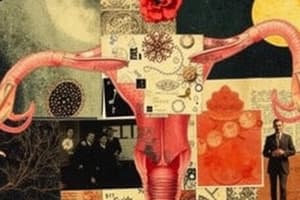Podcast
Questions and Answers
How does the poem explore gender roles?
How does the poem explore gender roles?
By depicting Aunt Jennifer's confinement to 'housework, her children,' and sewing.
What do Aunt Jennifer's tigers symbolize in the poem?
What do Aunt Jennifer's tigers symbolize in the poem?
The confinement and repression Aunt Jennifer faces.
What is the significance of Aunt Jennifer's embroidery in the poem?
What is the significance of Aunt Jennifer's embroidery in the poem?
It becomes a prison for her own spirit.
Explain the contradiction represented by Aunt Jennifer's tigers.
Explain the contradiction represented by Aunt Jennifer's tigers.
How does the poem address the concept of feminism?
How does the poem address the concept of feminism?
In what ways does the poem delve into the theme of domesticity?
In what ways does the poem delve into the theme of domesticity?
What does Aunt Jennifer's tigers symbolize in the poem?
What does Aunt Jennifer's tigers symbolize in the poem?
How does Walker's poem address the theme of gender roles?
How does Walker's poem address the theme of gender roles?
In what ways does Aunt Jennifer's creative expression defy societal expectations?
In what ways does Aunt Jennifer's creative expression defy societal expectations?
How does Walker's poem connect to the broader feminist movement of the 1970s?
How does Walker's poem connect to the broader feminist movement of the 1970s?
What is the significance of Aunt Jennifer's tigers in relation to domesticity?
What is the significance of Aunt Jennifer's tigers in relation to domesticity?
How does Walker's poem invite readers to consider women's artistic expression within gender roles?
How does Walker's poem invite readers to consider women's artistic expression within gender roles?
Flashcards are hidden until you start studying
Study Notes
Aunt Jennifer's Tigers: Unveiling Symbolism, Gender Roles, and Feminism
In the realm of poetry, Alice Walker's "Aunt Jennifer's Tigers" is a captivating work that invites inquiry into various layers of meaning. Through vivid imagery and sophisticated symbolism, Walker explores themes of gender roles, feminism, and domesticity—all within a single, enigmatic poem.
Symbolism
The title, "Aunt Jennifer's Tigers," refers to Aunt Jennifer, a personification of domesticity, and her tigers, symbolizing the confinement and repression she faces. The tigers, which are meticulously embroidered, are an extension of her own spirit, trapped within the walls of her house and the socially constructed roles of women in her time.
Walker's use of the tiger, a powerful and wild animal, is a poignant symbol of the inherent contradiction between the strength and resilience of women and the limitations and constraints imposed on them. The tigers, though tamed by Aunt Jennifer's needle, remain wild within the confines of the embroidery hoop—just as women's spirits remain untamed in the face of social expectations.
Gender Roles
The poem touches upon the ways in which women, such as Aunt Jennifer, are expected to conform to societal norms. She is confined to her "housework, her children," and the "woman's world" of sewing and child-rearing. Her embroidery, which might otherwise be a creative outlet, becomes a prison for her own spirit. Walker's use of Aunt Jennifer's tigers highlights the ways in which women's creativity and strength can be misunderstood or misdirected within the confines of traditional gender roles.
Feminism
Walker's poem, written in the 1970s, was part of a broader feminist movement that sought to break free from the constraints of traditional gender roles. Walker's exploration of Aunt Jennifer's tigers is a reflection of this movement. The poem highlights the struggle of women to express their creative spirit, their strength, and their resilience within a society that often sought to limit them.
Walker's poem is a powerful call for women to reclaim their creativity and agency in the face of societal expectations. The poem rejects the idea that women's creative expression must be limited to the role of "embroiderer of men's shirts" or the "keeper of the martinis cold." Instead, it calls for women to embrace their own strength, passion, and creativity, and to break free from traditional gender roles.
Domesticity
Despite her confinement, Aunt Jennifer's tigers are a testament to her creative spirit. Walker's poem is a reminder that even within the most restrictive of environments, women can find ways to express their creativity and strength. Aunt Jennifer's tigers are a symbol of resilience, a testament to her ability to find beauty and expression within the confines of her domestic life.
Walker's poem invites readers to consider the ways in which women's creativity can be expressed within traditional gender roles. It highlights the possibilities that exist, even within the most restrictive of environments, for women to find beauty, expression, and agency.
In conclusion, Alice Walker's "Aunt Jennifer's Tigers" is a powerful and thought-provoking exploration of symbolism, gender roles, feminism, and domesticity. Through vivid imagery and sophisticated symbolism, Walker invites readers to consider the ways in which women's creativity and strength can be misunderstood or misdirected within the confines of traditional gender roles. Her poem is a call for women to reclaim their creativity and agency and to break free from societal expectations. It is a powerful and moving reminder that even within the most restrictive of environments, women can find beauty, expression, and agency.
Studying That Suits You
Use AI to generate personalized quizzes and flashcards to suit your learning preferences.




